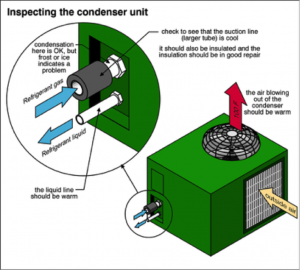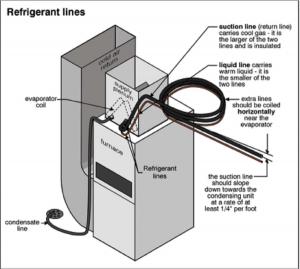Getting your A/C ready for the cooling season.
It is that time of year when summer approaches and we spend time on our gardens and lawns preparing them for summer; we also need to focus some attention on our Air Conditioning units. One of the most common questions I get asked about the A/C condensers outside is, “Should I cover my unit during the winter?” My answer to that question has always been that there are two schools of thought on the subject. Some say it’s best to leave it uncovered as it is designed to be exposed to the outdoors, and others say it is best to cover it. I believe there is some truth in both answers. If you are going to cover the unit, make sure you use a cover that is designed from the manufacturer for your condenser as it allows air to move and not trap moisture inside. Trapped moisture would of course over the long term add to the quicker development of corrosion and is one main reason why to never rap your condenser in plastic as I see sometimes done. I personally place a piece of plywood over my condenser and add a heavy rubber mat on top of that. You can use a few bricks as well to keep the plywood from moving. This setup prevents snow, ice, and debris from accumulating on the fan blades and allows air to circulate.
 Now back to preparing your A/C for summer. If you’re not very handy or your unit is older than five years old or you suspect a drop in performance; I would suggest having your HVAC technician come in and further evaluate your system. This would go beyond a simple clean up. However; if your unit has been performing consistently well, then a simple clean up should do. Firstly, turn off the power to your unit in the electrical panel. Remove your cover outside and visually check your condenser coil for any damage to the fins and dirt. If your fins are dirty you will need to clean them or if damaged you may purchase a fin comb or better yet, call your HVAC technician to help straighten them. Bent or damaged fins reduce performance in the heat transfer process.
Now back to preparing your A/C for summer. If you’re not very handy or your unit is older than five years old or you suspect a drop in performance; I would suggest having your HVAC technician come in and further evaluate your system. This would go beyond a simple clean up. However; if your unit has been performing consistently well, then a simple clean up should do. Firstly, turn off the power to your unit in the electrical panel. Remove your cover outside and visually check your condenser coil for any damage to the fins and dirt. If your fins are dirty you will need to clean them or if damaged you may purchase a fin comb or better yet, call your HVAC technician to help straighten them. Bent or damaged fins reduce performance in the heat transfer process.
If they are dirty, then simply running a hose with a light stream of water to help remove dirt and dust from in between the fins should be sufficient. Never use a pressure washer to clean your condenser as this could damage or bend the fins. There are also commercial foaming detergents that one could spray on the condenser coils to help dislodge dirt and debris from between the fins and then simply rinsed off.  This is something your technician may do to your Evaporator coil above the furnace every so often. This coil is not easily accessible and only your HVAC tech should clean this one when necessary. All the more reason to change your furnace filter religiously and reduce dirt and dust build up on your A/C evaporator coil.
This is something your technician may do to your Evaporator coil above the furnace every so often. This coil is not easily accessible and only your HVAC tech should clean this one when necessary. All the more reason to change your furnace filter religiously and reduce dirt and dust build up on your A/C evaporator coil.
Back to your exterior condenser coil; now that you have given her a good rinse, check your refrigerant lines for damage. You will see a large insulated suction line and a thinner liquid line. These lines are connected to your condenser unit and enter the home through the wall back to your evaporator coil above your furnace. These lines carry the refrigerant and transport the heat from your house and dump it outside via your condenser and fan. It’s all part of the refrigeration cycle. Any damage or kinks to these lines can lead to leaks or reduced performance and should be further evaluated by your Heating, Ventilation and Air Conditioning technician, and repaired as necessary. If they aren’t damaged, check the condition of the insulation on the thicker suction line. This insulation tends to deteriorate in the outdoors and sun. If it has lost its softness or flexibility, go to your hardware store and buy some in the plumbing section.  Take a small sample of the old one with you so you get the correct size. Now once you are done on the outside, go down to your furnace room and locate your condensate line and make sure it is clean and free from debris. Some of these lines are black plastic and you won’t be able to see any dirt. You either need to disconnect it and run water through it to flush it, listen and observe it during operation or simply once again call your HVAC tech. Check for any signs of water stains or rust on the cabinet which could be a sign of a leak somewhere. If you see any, call your HVAC tech immediately and have them further evaluate it.
Take a small sample of the old one with you so you get the correct size. Now once you are done on the outside, go down to your furnace room and locate your condensate line and make sure it is clean and free from debris. Some of these lines are black plastic and you won’t be able to see any dirt. You either need to disconnect it and run water through it to flush it, listen and observe it during operation or simply once again call your HVAC tech. Check for any signs of water stains or rust on the cabinet which could be a sign of a leak somewhere. If you see any, call your HVAC tech immediately and have them further evaluate it.
That is basically your A/C maintenance and steps needed to monitor your performance and condition of your Air conditioning system in your home. Remember, never operate your system when the temperature has been below 16-18*C over a 24 hour period. Doing so could damage your compressor in the Condenser Unit outside. Lastly, if ever you feel doing any of the maintenance steps is above your ability or confidence level, then always call your Technician to come and do it for you.  When he or she does, observe them so that you can learn and don’t be afraid to ask questions. The more your learn about your home, the better prepared you will be able to maintain its various systems and components. Now Go out there and give the TLC your A/C system deserves. A clean system reduces cost and increases performance. See you next time.
When he or she does, observe them so that you can learn and don’t be afraid to ask questions. The more your learn about your home, the better prepared you will be able to maintain its various systems and components. Now Go out there and give the TLC your A/C system deserves. A clean system reduces cost and increases performance. See you next time.

